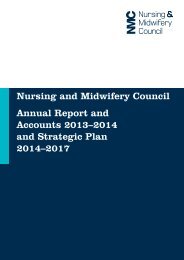Journal_1_2014_final_WEB
Journal_1_2014_final_WEB
Journal_1_2014_final_WEB
You also want an ePaper? Increase the reach of your titles
YUMPU automatically turns print PDFs into web optimized ePapers that Google loves.
Innovation, know how and technolgy in wound care<br />
<strong>2014</strong> EDUCATION ACTIVITIES<br />
Industry Course in Copenhagen<br />
MODULE 1: User-driven innovation<br />
Module 1: Introduction (for all participants)<br />
n Rapid innovation: Participants will engage in the<br />
product development process and try all steps of a<br />
generic process, from user interviews to the prototype/model<br />
building of their solution.<br />
Module 1a: User-driven innovation –the basics (for participants<br />
who are new to user-driven innovation)<br />
Participants will be introduced to the following aspects of<br />
user-driven innovation:<br />
n What is user-driven innovation? (Basic concepts:<br />
process and methods)<br />
n Why should we care about user-driven innovation?<br />
n What are the types of user-driven innovation and<br />
their characteristics, including product design and<br />
the development/implementation of service delivery<br />
models?<br />
Module 1b: User-driven innovation – new approaches<br />
(for participants with previous practical experience in userdriven<br />
innovation)<br />
Participants will be presented with the newest trends<br />
regarding user involvement:<br />
n What are the types of user-driven innovation and<br />
their characteristics, including product design and<br />
the development/implementation of service delivery<br />
models?<br />
n How can users be involved in new approaches, such<br />
as community-based innovation, online development<br />
forums, and need-based focus processes, in<br />
existing networks?<br />
MODULE 3: Organisational and work-practice<br />
challenges in the implementation of user-driven<br />
innovation processes<br />
Implementing new innovation methods into everyday<br />
R&D can lead to the development of new work practices<br />
and the training of employees.<br />
n How do we integrate new innovation methods into<br />
established work practices?<br />
n Why must user-driven innovation be an integrated<br />
part of corporate strategy and philosophy instead of<br />
isolated projects?<br />
MODULE 4: Generation of a business model<br />
that is focused on collaboration and value creation<br />
Opening up to new innovation methods can create new<br />
ways to see one’s company and develop how business models<br />
should be created for new solutions. The involvement<br />
of external partners can help identify new ways to define<br />
revenue structures, share expenses, and invite input to<br />
service delivery. However, navigating the complex constellation<br />
of private and public partners can present many<br />
challenges.<br />
n How do we involve partners when we are setting<br />
up our business model? (examples from the field of<br />
eHealth, e.g., telemedicine and exchange of patient<br />
data)<br />
n What tools for business model generation can have<br />
sustainable and long-term effects?<br />
n How can we establish collaborative innovation between<br />
public and private sectors using telemedicine<br />
ecosystems?<br />
MODULE 2: From needs to value creation<br />
One side of user-driven innovation is identifying the users’<br />
unmet needs. However, translating these needs to ideas<br />
that create value for the end users is another key area of<br />
expertise that requires training and experience.<br />
n How can unmet needs be converted into innovation?<br />
(examples within wound care)<br />
n Who are we creating value for in an innovation process?<br />
n Who should be involved in the development process,<br />
and when should it be done? (for example, end users<br />
and industry)<br />
MODULE 5: Trends in healthcare development:<br />
eHealth, telemedicine, and all that jazz<br />
New trends appearing within the healthcare sector involve<br />
telemedicine and independent living technologies. The<br />
traditional roles of healthcare partners are being challenged,<br />
and the demands from users continuously change.<br />
Therefore, it will be important to keep up with developmental<br />
trends in order to always stay one step ahead.<br />
n How can the industry become an active player in<br />
creating patient empowerment for chronic patients?<br />
n What is an example of innovation in service delivery?<br />
(case: Telemedicine in wound care)<br />
n What are the new trends and development paths in<br />
the regulatory field?<br />
<br />
EWMA <strong>Journal</strong> <strong>2014</strong> vol 14 no 1 67




